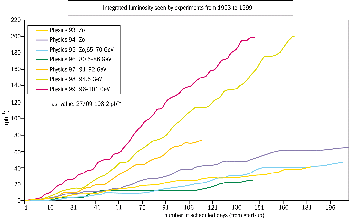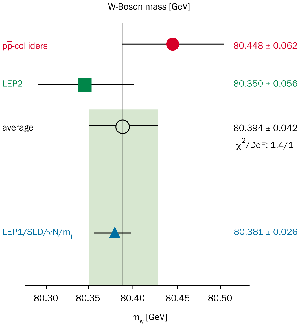While we wait for a definitive sighting of the enigmatic Higgs particle, there is no lack of careful precision work for the experiments at CERN’s LEP electronpositron collider. Bob Clare of MIT looks at the latest in LEP physics.

For the past two years, CERN’s LEP electronpositron collider has been performing better than ever. Each year sees new increases in collision energy and, just as important, new records in luminosity (a measure of the collision rate). Last year, LEP delivered about 200 inverse picobarns of luminosity to each of the four experiments and, as a result, almost quadrupled the collected data on W bosons (produced as oppositely charged pairs).
This year looks even more promising, with LEP reaching, and even slightly surpassing, the “magic” 200 GeV collision energy (100 GeV per beam). These new data have allowed the four LEP collaborations ALEPH, DELPHI, L3 and OPAL to extend and improve their studies at high energy. Of the many results presented recently at the EPS conference in Tampere, Finland, and the leptonphoton symposium at Stanford, the search for the Higgs boson and the measurement of the W mass were the highlights.
One of the first tasks in any new energy domain is to search for new particles. However, LEP is now exploring territory that could reveal the symmetry-breaking mechanism, at the heart of the Standard Model, that endows particles with mass (the “Higgs mechanism”). Although the Standard Model predicts that the Higgs particle should exist, unfortunately it says very little about its mass.
The Higgs should make its presence felt through delicate radiative corrections to the standard Z and W exchange mechanisms. These corrections have been studied in great detail by the LEP experiments, as well as by the SLD experiment at SLAC, Stanford, and the D0 and CDF experiments at Fermilab’s Tevatron protonantiproton collider. These studies indicate that the Higgs boson is relatively light. A fit to the LEP and SLC results on Z exchange, as well as the determinations of the W boson and top quark masses from LEP and the Tevatron, predict that the Higgs boson should be lighter than about 220 GeV, with a best fit at around 90 GeV. This is below the point where LEP is currently operating. A low-mass Higgs would be exciting. However, these suggestions are only indirect evidence.
The LEP experiments have been diligently searching for direct evidence of the Higgs since the beginning of LEP data taking. So far nothing has turned up. With no sign of a signal yet, the experiments express the non-observation as an upper limit on the Higgs production rate. At a given collision energy this depends on the Higgs mass and the upper limit on production rate can be converted into a lower limit on the Higgs mass.
Recently, following the example of the LEP Electroweak Working Group’s efforts to combine electroweak measurements, the LEP experiments have been combining their search results. The hope is that by combining the four experiments into a “meta-experiment”, with four times the luminosity, a signal might be detected that would be too small for an individual experiment to discover. Failing that, at least any mass limits could be increased.
Based on last year’s data, at a collision energy of 189 GeV, the combined lower limit on the Higgs mass from the four LEP experiments was 95.2 GeV. With the increased energy this year, the individual limits have also been increased to close to 100 GeV. It is too early to report on the combined limit. With the current limits so tantalizingly close to the value expected from the indirect evidence, the physicists at LEP are eagerly awaiting more data at even higher energies. The Higgs boson may be just round the corner.
W for weight
Compared with the lack of hard predictions on the Higgs boson, the Standard Model has somewhat more to say about the mass of the W boson. Via many of the same measurements that are used to constrain the Higgs boson indirectly, the experimenters (with a great deal of help from the theorists) have coaxed the Standard Model into predicting the mass of the W boson with an error of only 26 MeV (in 80 GeV). Now the challenge is to measure the W boson mass directly to the same accuracy, which will be a stringent test of the Standard Model.

This has been a major objective at LEP since 1996, when the energy was first raised above the threshold for producing pairs of W bosons. Since then the LEP experiments have been busy studying W bosons. Last year saw a fourfold increase in the LEP datasets, allowing the experiments to make dramatic improvements on the determination of the particle’s mass.
By now, each experiment has collected more than 4000 W pairs. With this amount of data the LEP experiments have been able to overtake their colleagues at protonantiproton colliders for the best direct W mass determination. The uncertainty on the LEP result is now 56 MeV, versus 62 MeV for the hadron collider result. Both measurements are in agreement with the indirect determination.

This year’s data will almost double the available statistics, and there are still more data to come next year. The LEP experimenters are hopeful that the final direct LEP W mass value will have an error of around 30 MeV, which is close to the error obtained indirectly.
The very first events were recorded by the LEP experiments on 13 August 1989. At that time the LEP energy was 91 GeV, which is right on the Z peak. Now, more than 10 years later and more than 100 GeV higher in energy, both the LEP machine and the LEP experiments are still going strong and the excitement is still mounting.





